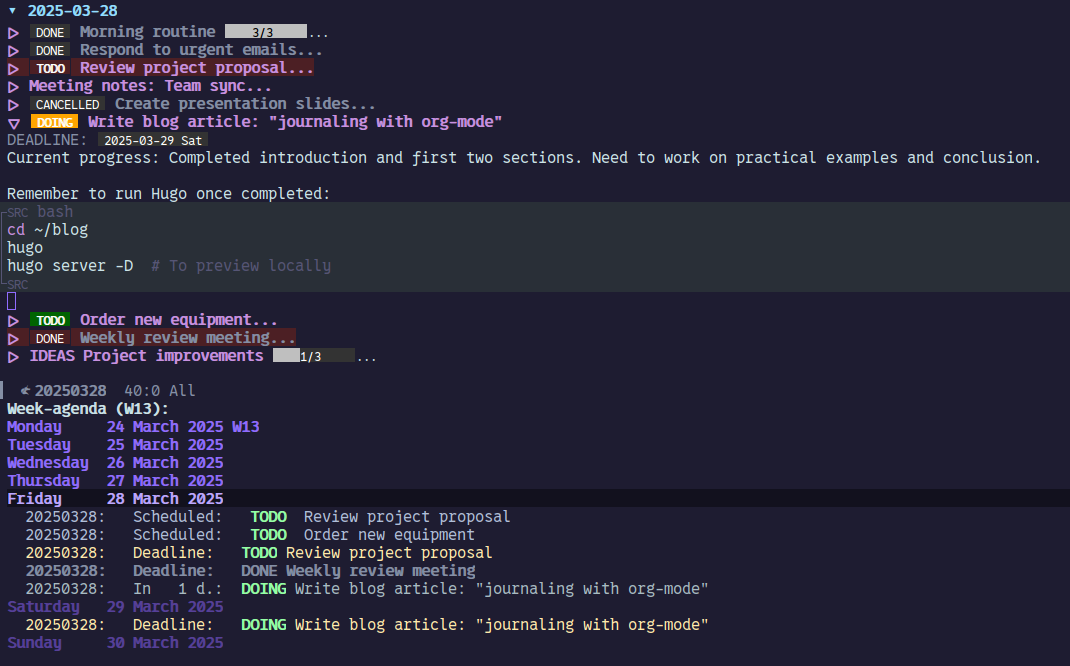As I delve into the intricacies of Emacs and its powerful org-mode ecosystem, I’ve discovered that org-journal has transformed my daily note-taking and task management workflow. Looking at the configuration shared, there are several valuable insights worth highlighting for anyone looking to enhance their personal knowledge management system.

The Power of Daily Granularity
One of the most impactful lessons I’ve learned is the importance of splitting journals into smaller, more manageable chunks. The configuration sets up org-journal with daily entries rather than maintaining one massive file for an entire year’s worth of thoughts and tasks. This approach offers several benefits:
- Improved Performance: Smaller files load faster and are less likely to cause Emacs to slow down
- Better Organization: Daily or weekly files create natural boundaries for your thoughts
- Easier Navigation: Finding specific entries becomes simpler when they’re organized by date
My configuration explicitly sets org-journal-dir to “~/org/journal” and uses the format (YYYYMMDD) for consistency and easy sorting.
Task Migration: Never Lose Track Again
A game-changing feature in org-journal is its ability to automatically move unfinished tasks to the next day’s entry. This prevents tasks from being forgotten in past journal entries and keeps your current day’s focus on what still needs attention.
Effective Agenda Management
The configuration reveals a crucial insight: simply journaling isn’t enough—you need to leverage org’s scheduling and deadline functions to create an effective overview of your commitments. The custom function _0x17de/org-highlight-todays-deadlines applies special highlighting to items due today, creating visual urgency for time-sensitive tasks.
Enhanced Task States with Custom Keywords
The standard TODO/DONE paradigm often feels inadequate for complex workflows. This configuration expands the vocabulary of task states:
(setq org-todo-keywords '((sequence "TODO" "WAITING" "DOING" "|" "DONE" "CANCELLED")))
Adding intermediate states like “WAITING” and “DOING” provides more context about where each task stands without requiring additional notes. The vertical bar separates active states from terminal states, a subtle but important distinction.
Visual Differentiation Through Custom Styling
The configuration goes beyond mere keywords by defining custom faces for different task states:
(org-modern-todo-faces '(("TODO" :foreground "white" :background "darkgreen" :weight bold)
("DOING" :foreground "white" :background "orange" :weight bold)
("WAITING" :foreground "white" :background "blue")))
This color-coding creates immediate visual feedback, making it easy to scan a journal page and instantly understand what’s in progress versus what’s waiting on external factors.
Modern Interface Enhancements
The use of org-modern-mode suggests an appreciation for clean, contemporary styling. This package enhances the visual appeal of org files with improved typography and modern design elements, making the journaling experience more pleasant.
Exploring New Frontiers: org-node
The configuration hints at exploration of org-node, a powerful package that enables treating org headings as nodes in a graph. This approach opens up interesting possibilities for knowledge management and connecting ideas across different journal entries and documents.
Convenient Keybindings for Quick Capture
Setting up a global keybinding (C-M-S-j) for creating new journal entries reduces friction in the journaling process. The fewer barriers to capturing thoughts, the more likely you are to maintain the practice consistently.
Integration with the Agenda
The configuration enables agenda integration with org-journal-enable-agenda-integration, ensuring that tasks and events from journal entries appear in your org-agenda views. This creates a unified system where your journal and task management seamlessly work together.
What’s Next?
For those inspired to explore this setup further, my complete Emacs configuration is available at https://github.com/0x17de/emacs-config. It offers additional insights into how these journaling practices fit into a broader productivity system.
As my own journey with org-journal continues, I’m particularly interested in diving deeper into org-node and exploring how graph-based knowledge management might enhance connections between journal entries over time.